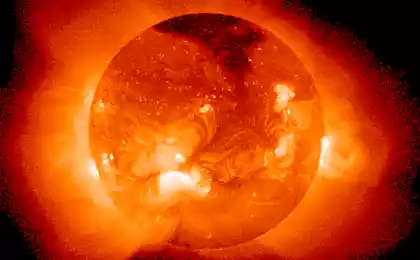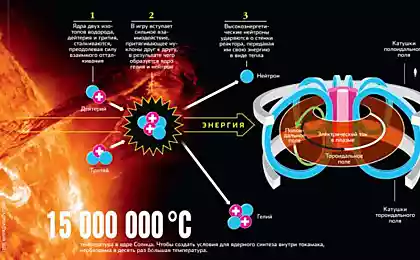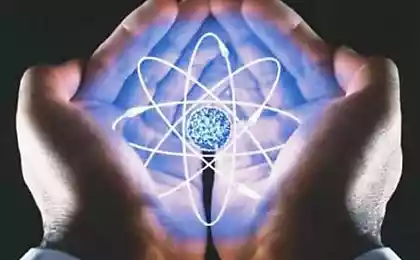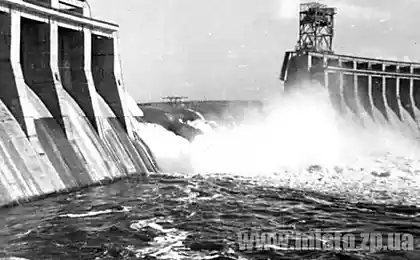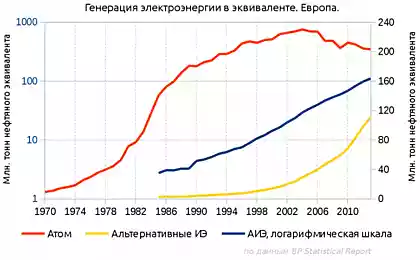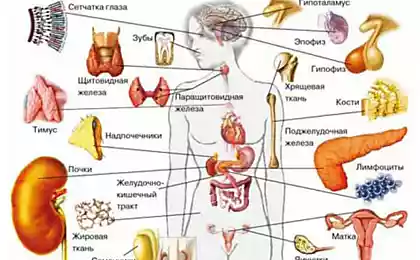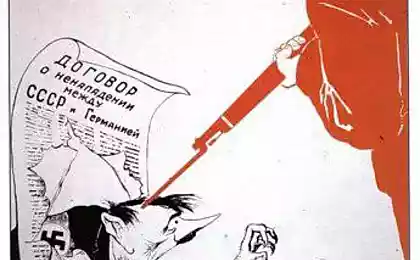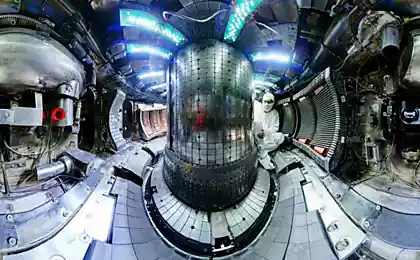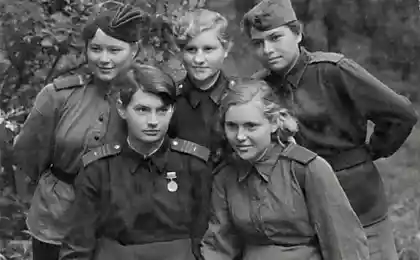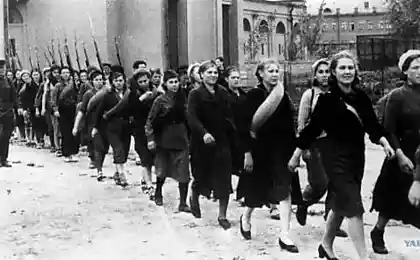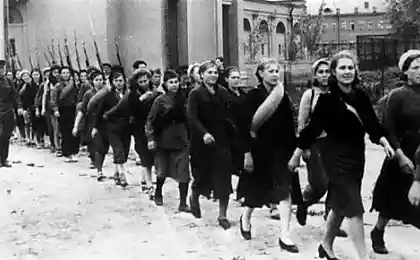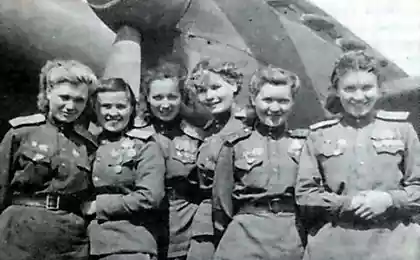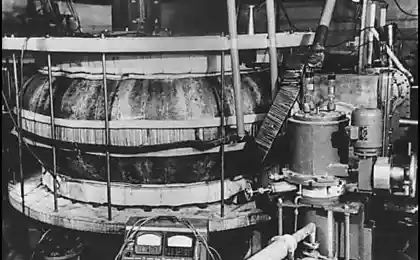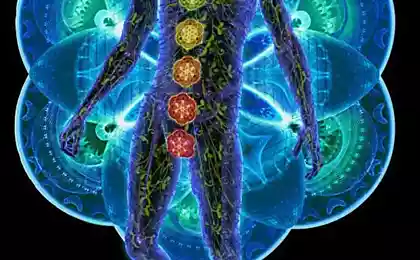1011
General fusional
Today I tell you about a project to create an alternate reactor of controlled thermonuclear fusion, which I personally like engineering for his absolute otherness of everything. It's about the Canadian startup General Fusion , has existed for more than 10 years and brought together for this time of the order of 100 million dollars for its development.
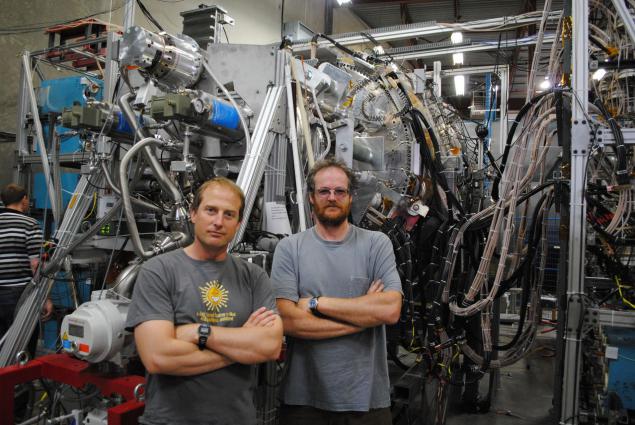
co-founder Doug Richardson (left) and Michel Laberge (right) in the background plasma injector for your car. I>
Now listen to what idea you can gather up as much money. In the spherical reactor GF hundreds of powerful steam hammers, arranged around the perimeter will synchronously rotating three-meter strike in the "drop" of molten lead, which would form a converging spherical wave. At the center of the drop is a vertical channel which injected plasma vortices of deuterium-tritium mixture. Similarly calculate the operation of the system will lead to a contraction exactly in the center of the liquid metal wall plasma formation and fusion reaction occurs, during which allocated the equivalent of the explosion of several tens of tons of TNT.
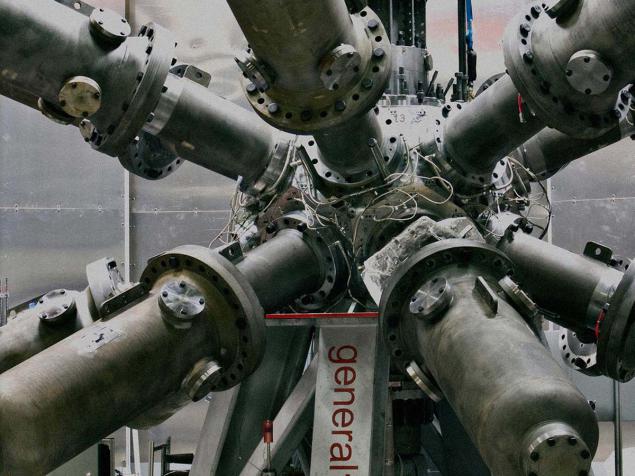
Experienced sphere with 14 steam hammer, which tested the principle of forming a converging shock wave. I>
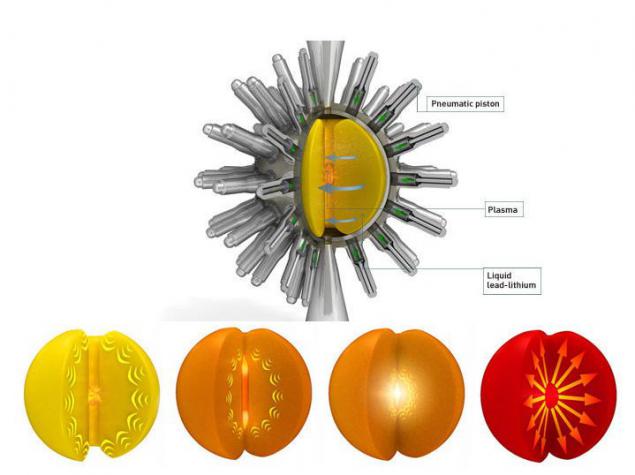
Project an image of a power reactor on this principle and consistency of his work. I>
Collapse liquid metal sheath around plasma vortices viewed as the driver of a thermonuclear reaction still in the 70s, in the conceptual installation LINUS. However, the 70s ... 80s - it was a time coming victory tokamaks, the first installations, attained manifestation of thermonuclear reactions. Before LINUS hands did not reach.
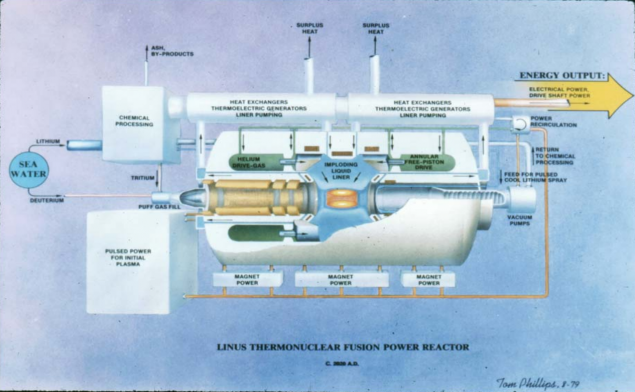
The original concept LINUS, 1979 i>
But in the 90s, when the disappointment tokamaks and magnetic traps in general, two alternative branches fusion devices based on inertial fusion ("Laser thermonuclear") and less well-known idea of compression of magnetized plasma (to this area such as here this group of projects, including the famous MagLIF , different pinch-setting, etc.) are being developed. Thus, if the inertial fusion is rapidly gaining support for military (ie, conditions in the target gets close to those that exist in thermonuclear weapons), the compression of magnetized plasma (FFP more) becomes a mecca for startups. The most famous of these are the Tri Alpha Energy, Helion Energy, and that's probably General Fusion.
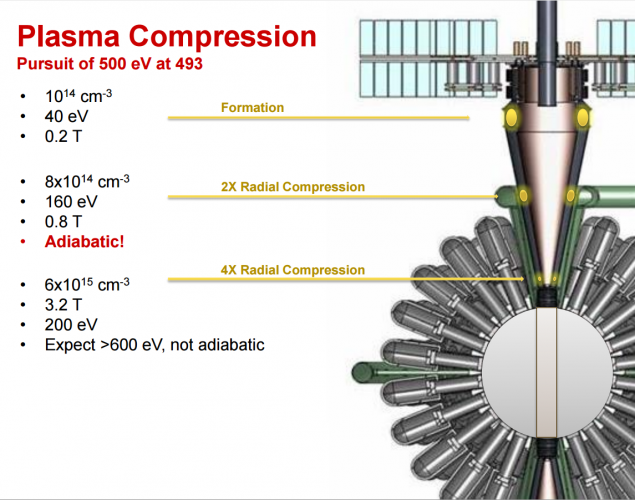
Work plasma injector. We see that even before the final compression of the liquid metal plasma compressed several times, raising the temperature of 2 million degrees and density to 0, 06% of the required for the fusion reaction. I>
Setting General Fusion is planned as a pulse - a thermonuclear micro-explosion every 2 seconds. The big advantage compared to other pulse settings is the lack of consumable items (holraumov, liners, cartridges, etc.) - you need only a drop of plasma and lead. Each burst is made 720 megajoules of heat which will be absorbed by the liquid metal and is discharged to the steam generator through the heat exchanger.
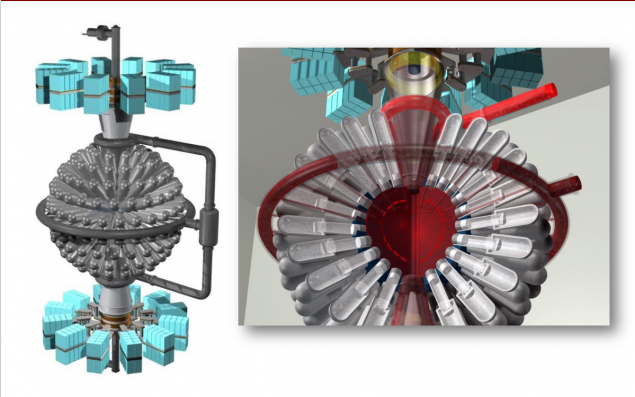
Project an image of a power reactor. Blue elements - high-voltage power supply of plasma injectors. I>
Part of the pair will work driver of steam hammers, and some produce 65 megawatts of electricity turbogenerator. Of course, in this installation will take a rather abstruse system of high-voltage powering the plasma arresters, cleaning lead, breeding tritium (GF believe that this can be done by mixing a liquid lithium lead. Absorbing thermonuclear neutrons it will fall apart in the helium and tritium), but to all this still have to live. In general, if the key point - the thermonuclear ignition - will be implemented against the background of other concepts fusion reactors it will be a breakthrough in terms of simplicity and low cost.
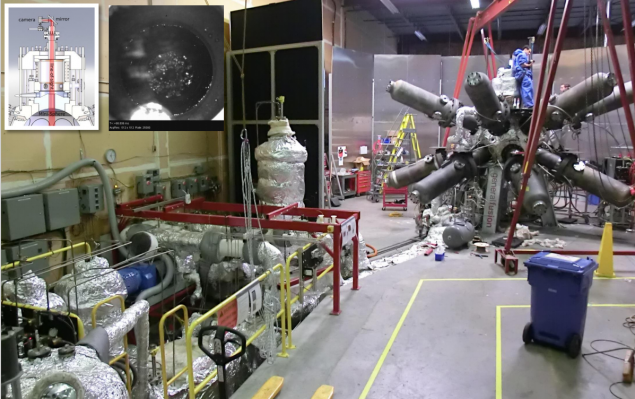
The current setting GF liquid metal loops, which in 2013 obtained spherical implosion of the right quality. I>
However, a key issue in all of this direction, and GF machines in particular, is the development of instabilities, which do not allow energy to be concentrated to the desired value, and useless to scatter it around. Any asymmetry and irregularities in compression will lead to the fact that positive energy output from this monster stimpankovskogo fail. This problem is of particular kinds of currently successfully buried more than a dozen concepts. Nevertheless, the brainchild of Michael LaBerge passed a number of checks in the early, stages of modeling, with open discussion of the results of the scientific community. This approach will also help attract many serious investors (including Amazon.com founder Jeff Bezos).
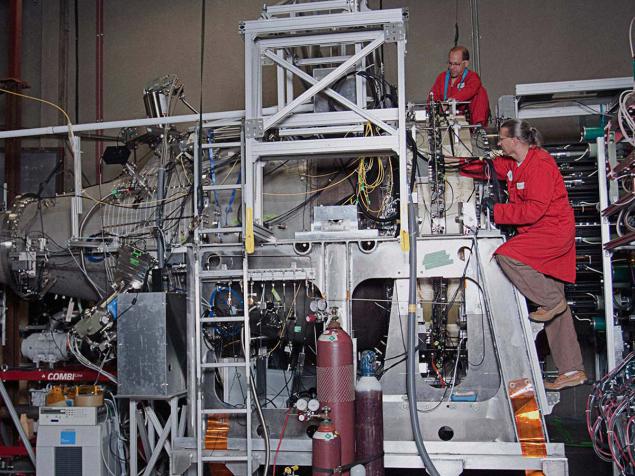
Set up plasma injector for tests. I>
While GF optimistic, although despite the successful prototyping of full-size all the elements of the machine (steam hammers, spheres with liquid lead dischargers - generators plasma vortices), and even of the machine itself is already two years show no results that likely indicates that that as well as dozens of other concepts in this field GF faced with great difficulties in the way of energy concentration.
Source: geektimes.ru/post/259936/

co-founder Doug Richardson (left) and Michel Laberge (right) in the background plasma injector for your car. I>
Now listen to what idea you can gather up as much money. In the spherical reactor GF hundreds of powerful steam hammers, arranged around the perimeter will synchronously rotating three-meter strike in the "drop" of molten lead, which would form a converging spherical wave. At the center of the drop is a vertical channel which injected plasma vortices of deuterium-tritium mixture. Similarly calculate the operation of the system will lead to a contraction exactly in the center of the liquid metal wall plasma formation and fusion reaction occurs, during which allocated the equivalent of the explosion of several tens of tons of TNT.

Experienced sphere with 14 steam hammer, which tested the principle of forming a converging shock wave. I>

Project an image of a power reactor on this principle and consistency of his work. I>
Collapse liquid metal sheath around plasma vortices viewed as the driver of a thermonuclear reaction still in the 70s, in the conceptual installation LINUS. However, the 70s ... 80s - it was a time coming victory tokamaks, the first installations, attained manifestation of thermonuclear reactions. Before LINUS hands did not reach.

The original concept LINUS, 1979 i>
But in the 90s, when the disappointment tokamaks and magnetic traps in general, two alternative branches fusion devices based on inertial fusion ("Laser thermonuclear") and less well-known idea of compression of magnetized plasma (to this area such as here this group of projects, including the famous MagLIF , different pinch-setting, etc.) are being developed. Thus, if the inertial fusion is rapidly gaining support for military (ie, conditions in the target gets close to those that exist in thermonuclear weapons), the compression of magnetized plasma (FFP more) becomes a mecca for startups. The most famous of these are the Tri Alpha Energy, Helion Energy, and that's probably General Fusion.

Work plasma injector. We see that even before the final compression of the liquid metal plasma compressed several times, raising the temperature of 2 million degrees and density to 0, 06% of the required for the fusion reaction. I>
Setting General Fusion is planned as a pulse - a thermonuclear micro-explosion every 2 seconds. The big advantage compared to other pulse settings is the lack of consumable items (holraumov, liners, cartridges, etc.) - you need only a drop of plasma and lead. Each burst is made 720 megajoules of heat which will be absorbed by the liquid metal and is discharged to the steam generator through the heat exchanger.

Project an image of a power reactor. Blue elements - high-voltage power supply of plasma injectors. I>
Part of the pair will work driver of steam hammers, and some produce 65 megawatts of electricity turbogenerator. Of course, in this installation will take a rather abstruse system of high-voltage powering the plasma arresters, cleaning lead, breeding tritium (GF believe that this can be done by mixing a liquid lithium lead. Absorbing thermonuclear neutrons it will fall apart in the helium and tritium), but to all this still have to live. In general, if the key point - the thermonuclear ignition - will be implemented against the background of other concepts fusion reactors it will be a breakthrough in terms of simplicity and low cost.

The current setting GF liquid metal loops, which in 2013 obtained spherical implosion of the right quality. I>
However, a key issue in all of this direction, and GF machines in particular, is the development of instabilities, which do not allow energy to be concentrated to the desired value, and useless to scatter it around. Any asymmetry and irregularities in compression will lead to the fact that positive energy output from this monster stimpankovskogo fail. This problem is of particular kinds of currently successfully buried more than a dozen concepts. Nevertheless, the brainchild of Michael LaBerge passed a number of checks in the early, stages of modeling, with open discussion of the results of the scientific community. This approach will also help attract many serious investors (including Amazon.com founder Jeff Bezos).

Set up plasma injector for tests. I>
While GF optimistic, although despite the successful prototyping of full-size all the elements of the machine (steam hammers, spheres with liquid lead dischargers - generators plasma vortices), and even of the machine itself is already two years show no results that likely indicates that that as well as dozens of other concepts in this field GF faced with great difficulties in the way of energy concentration.
Source: geektimes.ru/post/259936/
Correct bun with poppy seeds
Scientists at CERN are preparing "force field" to protect astronauts from radiation

